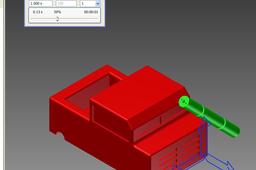Tutorial: How to simulate falling things in Autodesk Inventor

Just to clarify, steps 3,4,5 can be done in any order.
-
Step 1:
Prepare an assembly.
Create an assembly with the part you want to simulate falling and another part for it to fall on. If you already have an assembly you wish to simulate, use it and skip this step, but make sure it has two or more components (including the one destined to fall).

-
Step 2:
Start a Dynamic Simulation.
In the ribbon, click "Environments", then "Dynamic Simulation".

-
Step 3:
Create a Spatial Joint. This joint gives a part of the assembly 6 degrees of freedom.
First, click "Insert Joint" (in the ribbon, at the left), then in the drop down menu select "Spatial". Then, click on any surface on the part you want to fall, then on the "Insert Joint" window click on the first button under "Component 2", and lastly click on any surface on any other part of the assembly. Click "Apply".

-
Step 4:
Define Gravity.
On the assembly tree on the left, open "External Loads" (click on the "+" sign next to it). Click on "Gravity". In the window that opens, unselect "Suppress" (if it is selected), then click on a vertice in the assembly that goes in the direction of gravity is you want it. If the vector created is pointed in the wrong direction (i.e. up), click the button on the Gravity window that looks like a plane with two arrows purpendicular to it, one in each direction. If there isn't such a vertice, click on "Vector Components" in the Gravity window, and on its bottom provide the vector components of gravity as you want it.

-
Step 5:
Define a 3D Contact Joint. This tells the software two objects should touch each other when they meet, instead of going through one another.
First, click "Insert Joint" (in the ribbon, at the left), then in the drop down menu select "3D Contact". First, click on any surface on the component you want to fall, then click on any surface on a component it might meet while falling. Click "Apply". Repeat with all components the falling component will encounter in its movement.

-
Step 6:
Simulate.
Open the simulation player if it's not already opened, by clicking on "Simulation Player" in the ribbon (on the right). In the simulation player, click on the play button (the triangle pointing to the right).
You should see your component falling and bouncing off of other components.


